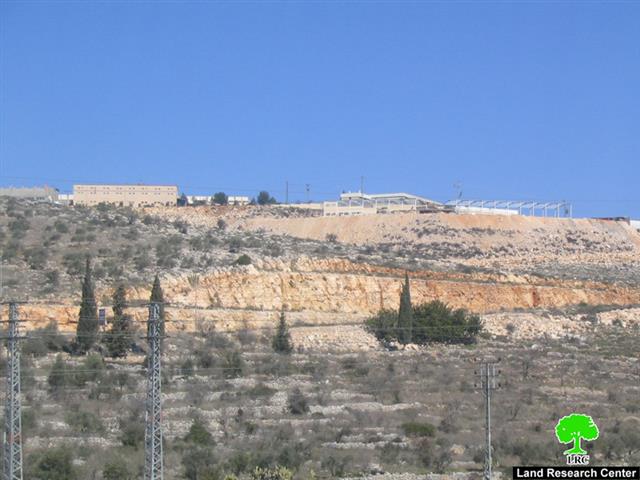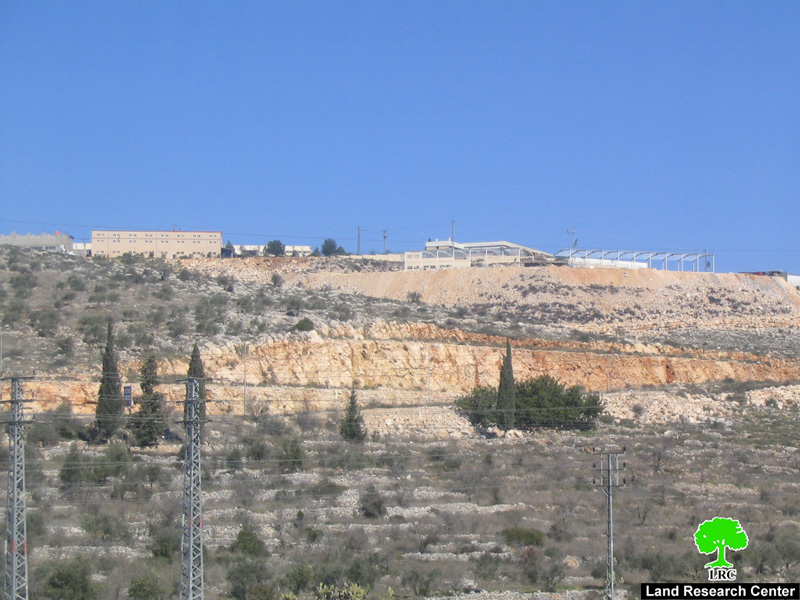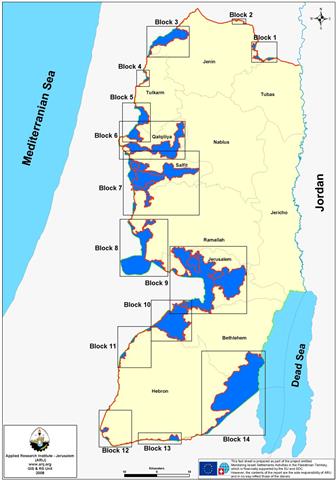Israeli occupation’s bulldozers embarked on expansion and excavation work on a large scale of some hills overlooking Barqan industrial compound and the ridges surrounding Ariel Parks industrial compound located to the west of Ariel settlement in Salfit Governorate. Up to date, more than 170 dunums in the vicinity of Barqan settlement and 80 dunums in the vicinity of Ariel Parks have been plowed and leveled. These lands belong to Palestinians from the villages of Haris, Bruqin and Sarta located west of the Governorate of Salfit.
(Photo 1 & Photo 2: Infrastrucural works running at the Settlement of Ariel – Salfit)
Meanwhile, Israeli Occupation authorities continue to establish new factories in Barqan industrial compound as expansion works are being carried out to bring additional Israeli factories from inside the 1949 Armistice Line (Green Line) to the West Bank Boundaries. The Israeli Authorities have been active in encouraging Jewish and foreign investors to invest in West Bank Settlements through providing them with commercial and industrial incentives (including tax deductions for individuals and companies) as well as providing advanced industrial basic infrastructure with preferential treatment when exporting to European countries.
It is worth mentioning that expansion works currently underway are considered a violation to the Israeli commitments of the Israeli side in the eve of Annapolis Meeting in late November 2007, which included an over-all freeze of colonial activities in the West Bank.
Moreover, a large number of Israeli factories' owners work on relocating their factories to the West Bank territory as to take advantage of the cheap Palestinian labor force which is not covered under Israeli labor laws; rather covered under the Jordanian labor law as the areas in which the factories are located in are considered to be “disputed lands”. As such, Palestinian laborers receive much lower salaries than their counterparts who work inside the 1949 Armistice Line (Green Line). In addition, Palestinians working in these factories usually work under difficult working conditions that contradict with the basic humanitarian rights of laborers.
The Settlements of Barqan and Ariel Parks and their Effect on Palestinian Environment:
The industrial settlement of Barqan was established on lands originally owned by Palestinians of Haris, Bruqin and Sarta villages in Salfit Governorate. It first started as a nucleus for an industrial settlement in 1981. Up to 2006, the settlement has confiscated about 2720 dunums of Palestinian lands where 349 dunums constitute the built-up area of the settlement where about 1300 settlers reside (ICB 2005). A number of factories are currently present in the settlement and designated for oil, plastic and lead productions.
Photo 3: Eliaho Zelman Company expanding at the expense of Palestinian lands in Salfit Governorate
Photo 4: Number of Burqan factories established on Salfit Land
Photo 5: Arie'l Commerce and industry colonial chamber which was established forcibly on SalfitLands
On the other hand, the so-called Ariel Municipality established in 1999 an industrial zone (known as Ariel Parks) in the western side of the settlement. Tens of agricultural dunums from the villages of Haris and Bruqin Salfit Governorate were confiscated for that purpose. Currently the zone has a number of factories designated for plastic productions.
It is worth mentioning that the continuous industrial production in these two zones have caused considerable damage to the Palestinian environment and a wide spread of diseases as the by-product effluents and sewages are usually pumped into Wadi Bruqin area where the closest Palestinian houses are located 6 meters away from the dumping site.
The Health and Environmental Effects of Burqan and Ariel Settlements:
The issue of the environmental impact of the afore-mentioned settlements has been raised a number of times in the Palestinian Ministry of Health as well as in some international Human Rights’ Organizations where a number of health reports have been issued in that regard. However, nothing has changed so far. On the contrary, facts on the ground indicate that there is increases in the quantities of pollutants produced by these settlements with an expectation of even larger quantities produced as these settlements continue to expand.
The continuous dumping of sewage waste from the settlements into the lands of Bruqin and Kufr Al Diek threatens to destroy the beautiful environmental in the area. It is also psychologically depressing as bad odors fill the air near the dumping sites. Plants and animals that depend on herding are also threatened with chemical and biological poisoning with a substantiated fear that such poisons might be transmitted easily to humans. In addition, the untreated waste water seeps into the underground water in these villages causing the pollution of springs used by Palestinians as attested to by water sample analysis carried out by the Palestinian Ministry of Health in 2007 on water samples from schools, homes and cisterns in the village of Bruqin.
In addition, the existence of polluted water in the valleys of the villages of Bruqin and Kafr Al Diek has led to the presence of a large number of insects especially mosquitoes that carry Al Shamania parricide. So far, 10 cases of infection of Al Shamania parricide in these two villages as well as in the nearby village of Sarta have been reported since the beginning of 2008. Moreover, the Palestinian Ministry of Health has also reported an increase in the number of Hepatitis A, diarrhea and cancer cases in the affected areas. It is also feared that a breakout of Typhoid might be at hand which would complicate the situation even further and make it uncontrollable.
( Map 1: Burqan Ariel Settlement )
Prepared by:
The Land Research Center
LRC




















